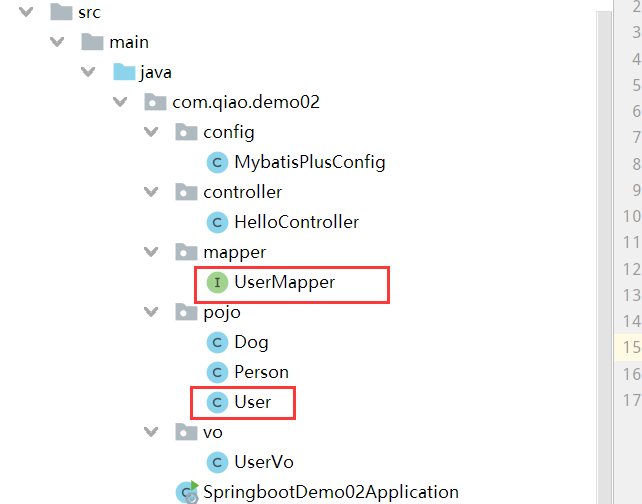在springboot中整合mybatis-plus
按照官方文档进行的配置:快速开始|mybatis-plus
引入依赖:
1 <!-- 引入mybatisPlus --> 2 <dependency> 3 <groupId>com.baomidou</groupId> 4 <artifactId>mybatis-plus-boot-starter</artifactId> 5 <version>3.2.0</version> 6 </dependency> 7 <!-- 引入mysql驱动包 --> 8 <dependency> 9 <groupId>mysql</groupId> 10 <artifactId>mysql-connector-java</artifactId> 11 <version>5.1.27</version> 12 </dependency> 13 <!-- 引入Druid依赖,阿里巴巴所提供的数据源 --> 14 <dependency> 15 <groupId>com.alibaba</groupId> 16 <artifactId>druid</artifactId> 17 <version>1.0.29</version> 18 </dependency>
在application.yml配置
1 spring: 2 datasource: 3 type: com.alibaba.druid.pool.DruidDataSource 4 driver-class-name: com.mysql.jdbc.Driver 5 url: jdbc:mysql://127.0.0.1:3306/test?useUnicode=true&characterEncoding=UTF-8 6 username: root 7 password: 123456
在启动类上面添加@MapperScan注解,扫描mapper包
1 @SpringBootApplication 2 @MapperScan("com.qiao.demo02.mapper") 3 public class SpringbootDemo02Application { 4 5 public static void main(String[] args) { 6 SpringApplication.run(SpringbootDemo02Application.class, args); 7 } 8 9 }
新建User和UserMapper

user类

1 @Data 2 public class User { 3 @TableId 4 private Integer userId; 5 private String userName; 6 private Integer userAge; 7 private String userEmail; 8 }
UserMapper接口

1 public interface UserMapper extends BaseMapper<User> { 2 3 }
最重要的是继承BaseMapper<E>接口:里面声明了很强大的CRUD方法

1 public interface BaseMapper<T> extends Mapper<T> { 2 int insert(T entity); 3 4 int deleteById(Serializable id); 5 6 int deleteByMap(@Param("cm") Map<String, Object> columnMap); 7 8 int delete(@Param("ew") Wrapper<T> wrapper); 9 10 int deleteBatchIds(@Param("coll") Collection<? extends Serializable> idList); 11 12 int updateById(@Param("et") T entity); 13 14 int update(@Param("et") T entity, @Param("ew") Wrapper<T> updateWrapper); 15 16 T selectById(Serializable id); 17 18 List<T> selectBatchIds(@Param("coll") Collection<? extends Serializable> idList); 19 20 List<T> selectByMap(@Param("cm") Map<String, Object> columnMap); 21 22 T selectOne(@Param("ew") Wrapper<T> queryWrapper); 23 24 Integer selectCount(@Param("ew") Wrapper<T> queryWrapper); 25 26 List<T> selectList(@Param("ew") Wrapper<T> queryWrapper); 27 28 List<Map<String, Object>> selectMaps(@Param("ew") Wrapper<T> queryWrapper); 29 30 List<Object> selectObjs(@Param("ew") Wrapper<T> queryWrapper); 31 32 IPage<T> selectPage(IPage<T> page, @Param("ew") Wrapper<T> queryWrapper); 33 34 IPage<Map<String, Object>> selectMapsPage(IPage<T> page, @Param("ew") Wrapper<T> queryWrapper); 35 }
分页查询
这点官方文档讲的也很详细:https://mp.baomidou.com/guide/page.html
新建一个config包,在里面建一个MybatisPlus配置类 返回一个分页拦截器
1 package com.qiao.demo02.config; 2 3 @Configuration 4 @ConditionalOnClass(value = {PaginationInterceptor.class}) 5 public class MybatisPlusConfig { 6 @Bean 7 public PaginationInterceptor paginationInterceptor() { 8 PaginationInterceptor paginationInterceptor = new PaginationInterceptor(); 9 return paginationInterceptor; 10 } 11 }
这样就能使用mybatis的分页功能了
Junit测试
1 @Resource 2 private UserMapper userMapper; 3 @Test 4 public void queryUserForPage(){ 5 IPage<User> userPage = new Page<>(2, 2);//参数一是当前页,参数二是每页个数 6 userPage = userMapper.selectPage(userPage, null); 7 List<User> list = userPage.getRecords(); 8 for(User user : list){ 9 System.out.println(user); 10 } 11 }
Controller返回json串
先定义一个包装类UserVo,用来保存分页所需要的数据
1 package com.qiao.demo02.vo; 2 3 @Data 4 public class UserVo { 5 private Integer current; 6 private Integer size; 7 private Long total; 8 private List<User> userList; 9 }
然后在控制器编写代码,这里省略了service层,实际开发业务代码写在service层,Controller只负责:接受参数、调用service层方法处理业务逻辑,返回结果
Controller类贴上了@RestController注解
1 @GetMapping("queryUser") 2 public UserVo queryList(Integer current, Integer size) { 3 /** 4 * 这些代码应该写在service层 5 */ 6 UserVo userVo = new UserVo(); 7 IPage<User> page = new Page<>(current, size); 8 userMapper.selectPage(page, null); 9 userVo.setCurrent(current); 10 userVo.setSize(size); 11 userVo.setTotal(page.getTotal()); 12 userVo.setUserList(page.getRecords()); 13 return userVo; 14 }
附上结果,前端直接处理json数据即可

